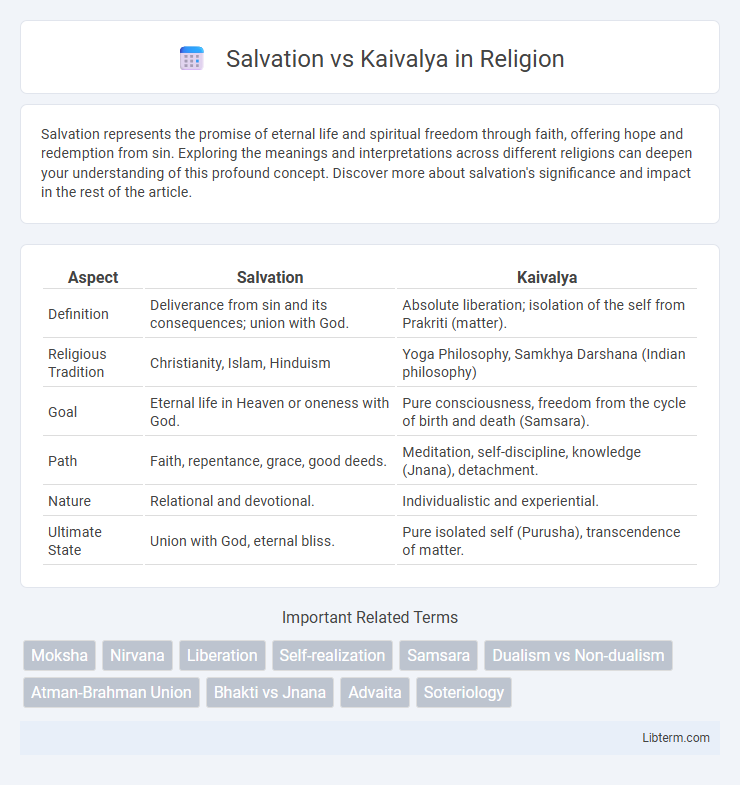Salvation represents the promise of eternal life and spiritual freedom through faith, offering hope and redemption from sin. Exploring the meanings and interpretations across different religions can deepen your understanding of this profound concept. Discover more about salvation's significance and impact in the rest of the article.
Table of Comparison
| Aspect | Salvation | Kaivalya |
|---|---|---|
| Definition | Deliverance from sin and its consequences; union with God. | Absolute liberation; isolation of the self from Prakriti (matter). |
| Religious Tradition | Christianity, Islam, Hinduism | Yoga Philosophy, Samkhya Darshana (Indian philosophy) |
| Goal | Eternal life in Heaven or oneness with God. | Pure consciousness, freedom from the cycle of birth and death (Samsara). |
| Path | Faith, repentance, grace, good deeds. | Meditation, self-discipline, knowledge (Jnana), detachment. |
| Nature | Relational and devotional. | Individualistic and experiential. |
| Ultimate State | Union with God, eternal bliss. | Pure isolated self (Purusha), transcendence of matter. |
Understanding Salvation: Core Concepts
Salvation, often understood as liberation from the cycle of birth and death, emphasizes union with the divine and eternal bliss through self-realization and surrender. Core concepts include moksha, where the soul attains freedom from karmic bondage, and the realization of oneness with Brahman or God. This contrasts with Kaivalya, which centers on absolute isolation of the self, highlighting distinct philosophical paths to ultimate freedom in Indian spiritual traditions.
Defining Kaivalya: Meaning and Origins
Kaivalya, a fundamental concept in classical Indian philosophy, signifies ultimate liberation characterized by absolute detachment and self-realization beyond the cycle of birth and death. Originating from the Sanskrit root "kevala," meaning "alone" or "isolated," Kaivalya is prominently described in Patanjali's Yoga Sutras as the state where the soul is isolated from material nature and attains pure consciousness. Unlike general notions of salvation that often involve reunion with a divine entity, Kaivalya emphasizes individual emancipation through internal transformation and the realization of the true self as distinct from the physical and mental layers.
Historical Roots of Salvation in World Religions
Salvation, rooted in ancient religious traditions, is often viewed as liberation from sin and worldly suffering, prominently seen in Christianity, Islam, and Hinduism. Historical texts like the Bible, Quran, and Vedas outline salvation's pathway through faith, divine grace, or righteous living. Kaivalya, originating in classical Indian philosophy and prominently in Patanjali's Yoga Sutras, emphasizes ultimate isolation or absolute emancipation of the self from material existence, differing significantly from salvation's relational and devotional aspects in other world religions.
Kaivalya in Yogic and Hindu Philosophy
Kaivalya in Yogic and Hindu philosophy signifies the ultimate state of liberation characterized by absolute detachment and self-realization, beyond the cycle of birth and death. Unlike Salvation, often interpreted as divine grace or union with God, Kaivalya emphasizes autonomous liberation achieved through disciplined yoga, meditation, and the dissolution of ego. It represents the pure isolation of the soul (Purusha) from material nature (Prakriti), leading to eternal freedom and transcendence.
Pathways to Salvation: Belief and Practice
Pathways to salvation in Hindu philosophy often emphasize Bhakti (devotion), Jnana (knowledge), and Karma (right action) as transformative practices leading to Moksha, the liberation from the cycle of birth and death. Kaivalya, primarily recognized in Yoga philosophy, is achieved through disciplined meditation and self-realization, resulting in absolute isolation of the purusha (self) from prakriti (material nature). Both concepts underscore a liberation goal, but salvation (Moksha) integrates devotional belief and ethical living, whereas Kaivalya centers on experiential knowledge and detachment through yogic practice.
Attaining Kaivalya: Methods and Disciplines
Attaining Kaivalya involves rigorous practices such as intense meditation, self-discipline, and detachment from material desires, as outlined in Patanjali's Yoga Sutras. The path emphasizes purification of the mind (chitta vritti nirodha) through ethical observances like Yama and Niyama, pranayama, and focused concentration (Dharana) leading to Samadhi. This discipline contrasts with salvation notions centered on divine grace, highlighting self-realization and liberation from samsara through direct experiential knowledge.
Salvation vs Kaivalya: Key Differences
Salvation in various spiritual traditions often represents liberation from the cycle of birth and death through union with a divine entity or ultimate reality, emphasizing eternal bliss and grace. Kaivalya, primarily in Yoga philosophy, signifies absolute isolation and independence of the self, characterized by pure consciousness detached from material existence and mental fluctuations. The key differences lie in Salvation's relational aspect with a divine power versus Kaivalya's self-established state of complete detachment and singular self-realization.
The Role of Divine Grace and Self-Effort
Salvation in many spiritual traditions emphasizes divine grace as the essential catalyst for liberation, where the soul's release from the cycle of rebirth is granted through the compassionate intervention of a higher power. Kaivalya, particularly in the context of Yoga philosophy, stresses intense self-effort, discipline, and inner purification as necessary to achieve absolute isolation of the purusha (self) from prakriti (matter), leading to supreme freedom. The interplay between divine grace and self-effort varies, but significant traditions assert that while self-effort prepares the seeker, ultimate liberation often requires the transformative influence of divine grace.
Salvation and Kaivalya in Modern Spirituality
Salvation in modern spirituality is often viewed as liberation from suffering through awakening to one's true self and unity with the divine consciousness, emphasizing compassion and self-realization. Kaivalya, rooted in ancient yogic philosophy, signifies absolute isolation of the soul, representing pure independence and emancipation from all worldly bonds and mental fluctuations. Both concepts converge on ultimate freedom but differ in their ontology and practice, with Salvation leaning towards devotional union and Kaivalya emphasizing existential detachment and self-mastery.
Integrating Salvation and Kaivalya Today
Integrating Salvation and Kaivalya today involves harmonizing spiritual liberation with ultimate self-realization, emphasizing the unity of divine grace and individual purification. Modern seekers explore practices that balance devotion (bhakti) with disciplined meditation to achieve both eternal bliss and absolute freedom from worldly suffering. This approach fosters a holistic understanding where liberation transcends religious boundaries, blending personal experience with universal consciousness.
Salvation Infographic

 libterm.com
libterm.com